
IEEE Madison Section - 2006 Meeting Archive
Institute of Electrical and Electronics Engineers

Speaker: Dennis Bahr, P.E., President and CEO, Bahr Management, Inc.
Location: Rocky Rococo's Pizza
7952 Tree Lane (Madison Beltline Hwy. at Mineral Pt. Rd.),
608.829.1444
Menu: Pizza buffet, salad and soft drinks
Lunch Price: $10.00 (free for UW-Madison Student Branch members)
RSVP by January 16th to Les Schroeder via email or call 608.444.9144
Non-member guests are always welcome!
Auscultatory blood pressure measurement uses the presence and absence of acoustic pulses generated by an artery (i.e., Korotkoff sound), detected with a stethoscope or a sensitive microphone, to non-invasively estimate systolic and diastolic pressures. Unfortunately, in high noise situations, such as ambulatory environments or when the patient moves moderately, the current auscultatory blood pressure method is unreliable, if at all possible. Empirical evidence suggests that the pulse beneath an artery occlusion travels relatively slow compared with the speed of sound. By placing two microphones along the bicep muscle near the brachial artery under the occlusion cuff, a similar blood pressure pulse appears in the two microphones with a relative time delay. The acoustic noise, on the other hand, appears in both microphones simultaneously. The contribution of this new technique is to utilize this phenomenon by filtering the microphone waveforms to create spatially narrowband information signals. With a narrowband signal, the microphone signal phasing information is adequate for distinguishing between acoustic noise and the blood pressure pulse. By choosing the microphone spacing correctly, processing of the two signals will enhance the information signal and cancel the noise signal.
The photoplethysmographic signals acquired during pulse oximetry can be compromised in many ways. Intrapartum fetal pulse oximetry in particular presents challenges to signal processing. Period domain analysis can overcome the low pulsatile amplitudes, noise, and maternal modulation found in these signals. The efficiency of an incremental algorithm reduces the processing requirements for period domain analysis, facilitating use in low-power and portable devices.
Mr. Dennis Bahr, PE was instrumental in starting nine companies in the Madison and Milwaukee area. During his tenure with these companies he was involved in corporate management, team management, technology transfer, and raising capital. He is presently active in one of these companies (Bahr Management, Inc.) as it's President and CEO. Bahr Management owns portions of the other companies that Mr. Bahr is still involved with.
Mr. Bahr holds a BS degree in Electrical Engineering and an MS degree in Electrical and Biomedical Engineering from the University of Wisconsin and is an Licensed Professional Engineer in the State of Wisconsin. He was an Adjunct Professor in the Electrical and Computer Engineering Department at the University of Wisconsin in Madison where he taught courses in logic design and advanced digital design.
Mr. Bahr is an Associate Fellow of the American Institute of Aeronautics and Astronautics and the past Chairperson of the Wisconsin Section. He is a Senior Member of the Institute of Electrical and Electronics Engineers and is the past Chairperson of the Madison Section. He is also a member of Sigma XI, the scientific research society. Mr. Bahr has written twenty (20) papers, a chapter for a book on biomedical instrumentation, and holds ten (10) US patents with one (1) additional US patent pending.
Speaker: Dr. Rob Williamson, Director of Marketing, Alfalight, Inc.
Location: Rocky Rococo's Pizza
7952 Tree Lane (Madison Beltline Hwy. at Mineral Pt. Rd.),
608.829.1444
Menu: Pizza buffet, salad and soft drinks
Lunch Price: $10.00 (free for UW-Madison Student Branch members)

Speaker: Kenneth Hartman,
VP of Operations and Chief Security Officer,
Visonex, LLC
Location: Rocky Rococo's Pizza
7952 Tree Lane (Madison Beltline Hwy. at Mineral Pt. Rd.),
608.829.1444
Menu: Pizza buffet, salad and soft drinks
Lunch Price: $10.00 (free for UW-Madison Student Branch members)
RSVP by March 13th to Les Schroeder via email or call 608.444.9144
Non-member guests are always welcome!
Internet technology is becoming more ubiquitous every day. There is tremendous demand for "web-enabled" or "smart" devices, such as photocopiers that email a service technician when a repair is needed. This technology, based on open TCP/IP standards, is also rapidly starting to replace the traditional control networks used in manufacturing because of its lower cost of ownership. Along with the huge benefits of using TCP/IP on the plant floor come the same information security concerns that rage on the Internet - except that now it affects the control of equipment. At stake is the health and safety of plant employees, product integrity, as well as economic repercussions. Most information security professionals do not understand the special needs of machine control networks or embedded controllers and many controls engineers do not relish the idea of the outside interference with how they design 'their' solutions. Security by obscurity is no longer adequate.
This discussion will discuss the security challenges and decisions facing organizations that use TCP/IP for control networks. It will give decision makers, designers, and project managers a very practical perspective of the challenges as well as potential solutions and resources to combat the challenges.
Kenneth Hartman is the VP of Operations and Chief Security Officer for Visonex, LLC. Visonex is a medical informatics company that serves dialysis centers. Prior to joining Visonex, Ken worked for Kraft Foods for ten years in a variety of maintenance, engineering and management positions. Ken has also worked for The Dial Corp. as a process engineer and at Grede Foundries as a project engineer. Ken attended Michigan Technological University and holds a BSEE with an Automatic Controls Systems specialization. Ken is serving as the 2006 Vice-Chair for the Madison IEEE Section.

Speaker: SRC staff
Location: Synchrontron Radiation Center, Stoughton, SRC Map
RSVP to Brian Cunningham via email or call 414.475.2164
This tour has been arranged by the IEEE Milwaukee Section but they are holding a few spots for IEEE Madison Section members that wish to attend. Please contact Brian Cunningham of the Milwaukee Section directly to reserve a spot.

Speaker: Pat Ringler, P.E., PMP, Project Manager, Alliant Energy
Location: Tong Auditorium, UW Engineering Centers Building,
1550 Engineering Drive - parking in lot 17
Menu: TBD
RSVP by April 10th to Les Schroeder via email or call 608.444.9144
Non-member guests are always welcome!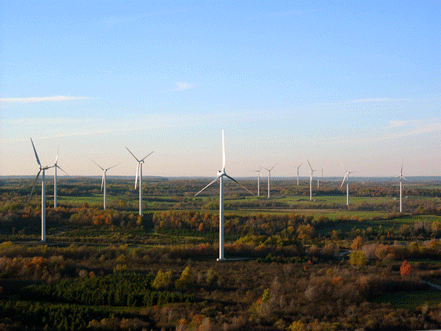
The Maple Ridge Wind Farm, sitting atop the Tug Hill plateau in Lewis County, New York, was commissioned near the end of 2005 with an ultimate output of 320 MW. This is the largest wind farm East of the Mississippi River, commissioned to date. It connects into the transmission grid via two substations and a new transmission line: a 34.5kV-230kV step-up collector substation, a 230kV Ring-bus switching substation, and a 10.5 mile 230kV transmission line in between.
Pat Ringler will share some of Alliant Energy's experiences with the design, construction and commissioning of the Maple Ridge Wind Farm in Lewis County, New York. This presentation will be full of photos of the plant and substations during and after construction.
Pat Ringler has 25 years of engineering, construction and project management experience in the utility and heavy construction industry. Pat has designed and managed the construction of many large projects including wind generation facilities, EHV transmission lines, substations, distribution lines, water treatment plants, and medical facilities. He provides project management and engineering services to developers of renewable energy facilities, municipal utilities and industrial clients. He holds degrees in Civil Engineering, Business Management, and Building Construction.
For a video of the Wind Farm as it was being commissioned, please point your browser at: http://www.news10now.com/content/top_stories/default.asp?ArID=55931

Speaker: Dr. Rob Williamson, Director of Marketing, Alfalight, Inc.
Location: Rocky Rococo's Pizza
7952 Tree Lane (Madison Beltline Hwy. at Mineral Pt. Rd.),
608.829.1444
Menu: Pizza buffet, salad and soft drinks
Lunch Price: $10.00 (free for UW-Madison Student Branch members)
RSVP by April 17th to Les Schroeder via email or call 608.444.9144
Non-member guests are always welcome!
High-power diode lasers are a key component in a broad range of applications, including telecommunications, industrial lasers for material processing, as well as in defense, medical, printing, display, and scientific applications. Recent research and development efforts have made tremendous improvements in many of the key performance characteristics of diode lasers, including power conversion efficiency, spatial brightness, and spectral quality. These performance boosts have substantial impact on a wide range of systems pumped by high-power diode lasers.
This talk will outline the properties and operating principles of high-power infrared diode lasers and the manufacturing processes used to make them, highlighting how these recent revolutionary performance improvements have been achieved. We will also explore the architectures of several systems incorporating diode lasers, including optical communications (CATV/FTTH), high power fiber lasers for material processing (cutting and welding), free-space communications, and kilowatt-class lasers.
Rob Williamson is currently the Director of Marketing at Alfalight, a high-power diode laser manufacturer in Madison, Wisconsin. In his previous roles, he has led the development and marketing of high-speed optical communication devices, ultrastable lasers, and other optoelectronic instruments for telecommunication and industrial applications. Dr. Williamson has a Ph.D. in Physics from the University of Wisconsin - Madison and a B.S. in Physics from Caltech. He holds four patents, has published numerous papers and articles, and has led development efforts in the IEEE Ethernet Standards Committee. He is a member of IEEE Lasers and Electro-Optics Society, the American Physical Society, and Sigma Xi.
Speaker: Jeff Cherwinka, IceCube - EHWD
Location: Rocky Rococo's Pizza
7952 Tree Lane (Madison Beltline Hwy. at Mineral Pt. Rd.),
608.829.1444
Menu: Pizza buffet, salad and soft drinks
Lunch Price: $10.00 (free for UW-Madison Student Branch members)
RSVP by May 15th to Les Schroeder via email or call 608.444.9144
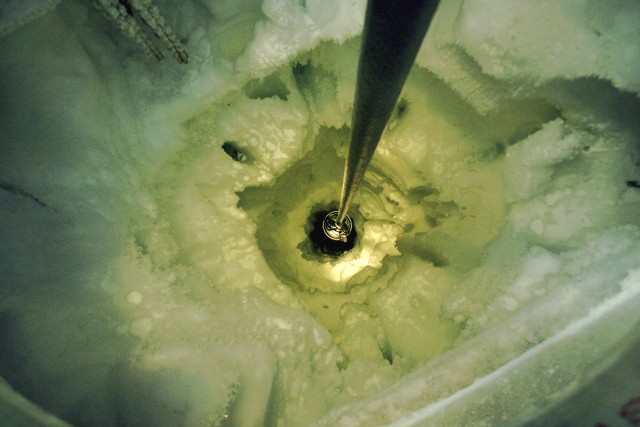
Non-member guests are always welcome!
IceCube is the largest neutrino telescope in the world after two seasons of construction at the South Pole. This talk will present a brief introduction to what neutrinos are, what they might tell us about the universe, and how IceCube is designed to gather this information. The construction of IceCube requires drilling 2.5 km deep holes in the ice at the South Pole to allow installation of sophisticated light detection equipment in the deep clear ice. Some of the details and challenges of the logistics, drilling, and instrument deployment will also be discussed. More information about the IceCube project can be found online at http://icecube.wisc.edu/.
Tourguide: Richard Schmidt
Location: Tomotherapy's New Facility (see map below)
1209 Deming Way, Madison, WI
608.824.2800
Menu: An informal lunch get together will occur at Houlihans at 11:00 AM
1262 John Q Hammons Dr (see map below)
608.827.0334
RSVP by September 18th to Les Schroeder via email or call 608.444.9144

Note that there will be a limit of 50 people on the tour. IEEE members and student members will be given preference. Please refrain from bringing any recording devices, including cameras and camera phones.
Non-member guests are always welcome!
The TomoTherapy Hi·Art System® introduces the Tomo® Process, a new way to deliver radiation treatment for cancer. It delivers a very sophisticated form of IMRT, or intensity modulated radiotherapy, and integrates treatment planning, patient positioning, and treatment delivery in one system.
It is the most advanced radiation delivery system available:
The TomoTherapy Hi·Art System® combines IMRT with a helical delivery pattern to deliver the radiation treatment. Photon radiation is produced by a linear accelerator, which travels in multiple circles around the gantry ring as the couch moves through the gantry. The linac moves in unison with a multileaf collimator, or MLC, which constantly modulates the radiation beam as it leaves the accelerator.
The IEEE is honored to have been invited to a tour of TomoTherapy's new facility. Please join us.
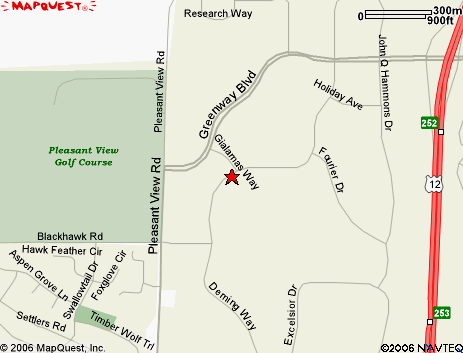 |
| TomoTherapy Map |
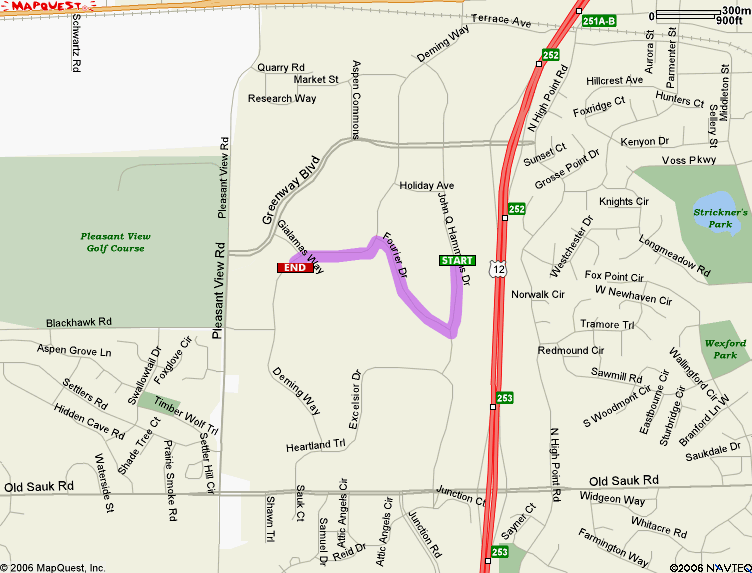 |
| Houlihan's to TomoTherapy Map |
This announcement is being sent by the Madison Section of the IEEE as a service to it's members. A tour of a wind farm near Fond du Lac is being conducted by We-Energies. Please see details below. Madison members can carpool together or drive separately. I will accept emails from those either offering seats in their vehicles or looking to catch a ride with others - Mitch Bradt. I personally cannot offer a ride back, as I will be heading on from Byron before returning to Madison later in the afternoon.
Mitch Bradt
IEEE Madison Section Chair and Wind Geek
Take a tour of the We Energies Byron wind turbines Saturday, Sept. 23. The guided tours take about 30 minutes and begin every half hour between 9:00 a.m. and 12:00 p.m. Visitors will have an opportunity to enter the tower base and watch the wind turbine shut down and be restarted.
Constructed in 1999, the two wind turbines feature 75-foot blades mounted on 215-foot steel towers, for a total height of 290 feet. Depending on wind speed, each turbine can generate 660 kilowatts of electricity for a total output of 1.3 megawatts.
Representatives from RENEW Wisconsin, Focus on Energy and the Midwest Renewable Energy Association also will be on site to answer questions about customer-owned wind turbines and solar installations. Tour reservations are not needed for individuals or small groups.
For more info, including a map, point your browser at http://www.we-energies.com/wind.
Speaker: Mike Ross, P.E., Principal T&D Planning Engineer, American Superconductor
Location: Rocky Rococo's Pizza
7952 Tree Lane (Madison Beltline Hwy. at Mineral Pt. Rd.),
608.829.1444
Menu: Pizza buffet, salad and soft drinks
Lunch Price: $10.00 (free for UW-Madison Student Branch members)
RSVP by October 16th to Les Schroeder via email or call 608.444.9144
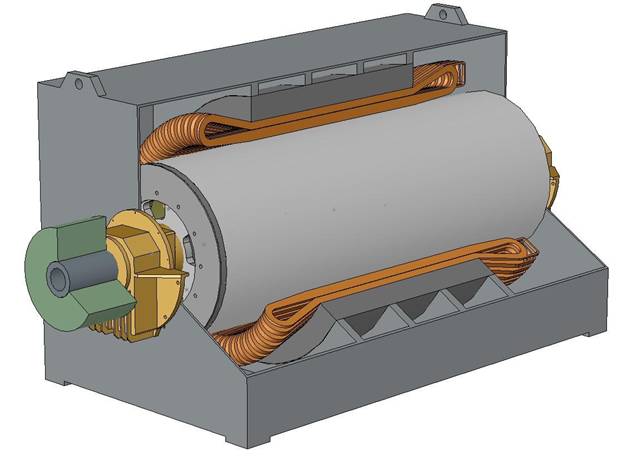
Non-member guests are always welcome!
This presentation will be an introduction of the high temperature superconducting dynamic synchronous condenser or "SuperVAR." There will be a brief update on today's high temperature superconducting industry and a detailed description of the SuperVAR device including the topology, performance, and applications. A Synchronous Condenser is a synchronous machine with no prime mover that is connected to the electric grid to provide VAR support during disturbances. We will discuss the aspect of the device that makes it better than a conventional synchronous condenser and will explore the lessons AMSC learned in the first installation of a SuperVAR at a steel mill in Tennessee. Questions will be fielded regarding the SuperVAR and superconducting technologies in general.
Michael Ross is a Principal Transmission and Distribution Engineer with American Superconductor of Middleton, WI and has been with the company for 6 years. Previously Mike worked for Northern States Power (now Xcel Energy) of Minneapolis in the Planning Department. Mike has a Bachelors Degree in Electrical Engineering from North Dakota State University. Mike is a registered Professional Engineer in the State of Wisconsin and an IEEE member.
Speaker: Professor Paul Wilson, PhD, University of Wisconsin Energy Institute
Location: Rocky Rococo's Pizza
7952 Tree Lane (Madison Beltline Hwy. at Mineral Pt. Rd.),
608.829.1444
Menu: Pizza buffet, salad and soft drinks
Lunch Price: $10.00 (free for UW-Madison Student Branch members)
RSVP by November 6th to Les Schroeder via email or call 608.444.9144
Non-member guests are always welcome!
A renaissance in nuclear energy appears to be taking hold - over 30 new reactors are currently being considered for license applications and construction in the next 10-15 years. If completed, this would represent a 30% increase in the number of reactors and closer to 40% increase in installed capacity. But just 10 years ago, the nuclear industry was planning for its own demise. What has changed to put nuclear energy back on course? What of the lingering technical and political issues? This presentation will highlight the major operational gains made by nuclear energy in the last decade, discuss the global issues supporting new nuclear energy and present a number of research areas being pursued to further improve the prospects for the global deployment nuclear energy.
Paul Wilson joined the University of Wisconsin-Madison's Engineering Physics department in 2001, and is a founding member of the University's Energy Institute. His research interests bring together technical and policy issues surrounding energy needs and the role that nuclear has to play. Born in Edinburgh, Scotland, and raised in Fort Saskatchewan, Alberta, Canada, Paul specialized in the Nuclear Power option of the Engineering Science program at the University of Toronto. After receiving his Bachelor of Applied Science in Engineering Science, he began his graduate schooling in nuclear engineering at the University of Wisconsin-Madison. After three years, he moved to Karlsruhe, Germany, where he studied in the Institute for Neutron Physics and Reactor Engineering, earning his Dr.-Ing. degree in Mechanical Engineering in 1998. Returning to Madison, Paul completed his Ph.D. in Nuclear Engineering in 1999.

Speaker: Kevin J. Kelbel, CPA, MBT, Smith & Gesteland
Location: Rocky Rococo's Pizza
7952 Tree Lane (Madison Beltline Hwy. at Mineral Pt. Rd.),
608.829.1444
Menu: Pizza buffet, salad and soft drinks
Lunch Price: $10.00 (free for UW-Madison Student Branch members)
RSVP by December 18th to Les Schroeder via email or call 608.224.0664
Non-member guests are always welcome!
Whether you are involved with a high technology business from the standpoint of a founder, employee, investor, customer or service provider, it is important to be aware of the critical aspects of the business. Essential to this goal is to understand these criteria from a business perspective and how that interacts with your involvement in the business. An understanding of the key factors of success will better enable you to add value to the enterprise.
While the successful launching and growth of a technology business requires several key factors, the primary early factor is planning and understanding what it will take to meet the company objectives. While these objectives may change as the business evolves and your market takes shape, the enterprise needs to have a plan of action. As the saying goes, "those that fail to plan, plan to fail".
As the high technology sector takes on a growing importance in the business economy of Wisconsin we will discuss the needs of such businesses, the factors they need to consider in growing a successful business, funding options and how the Wisconsin marketplace is adopting to meet these needs. Our discussion will give you a better understanding of the needs of technology based businesses and better position you to meet these needs.
Kevin Kelbel received his undergraduate degree in accounting from Viterbo University and his Masters in Taxation from the University of Minnesota. He spent seven years with the international accounting firm of KPMG Peat Marwick in their Minneapolis office and joined Smith & Gesteland, LLP in Madison in 1994. Kevin has served high technology businesses for the majority of his career and is very active in the development of the high technology economy in Wisconsin.